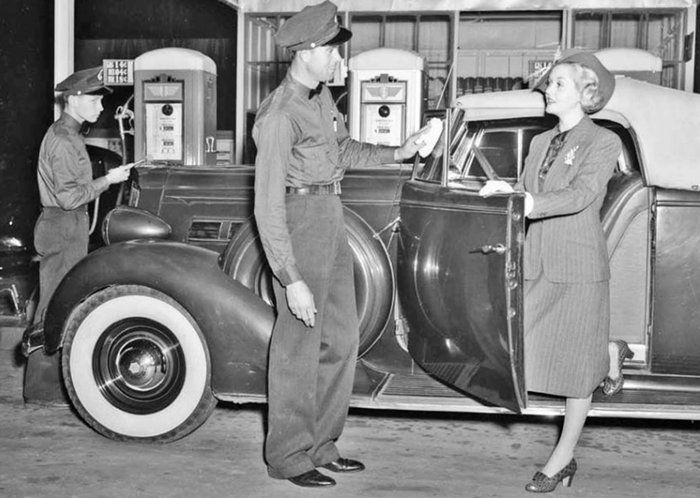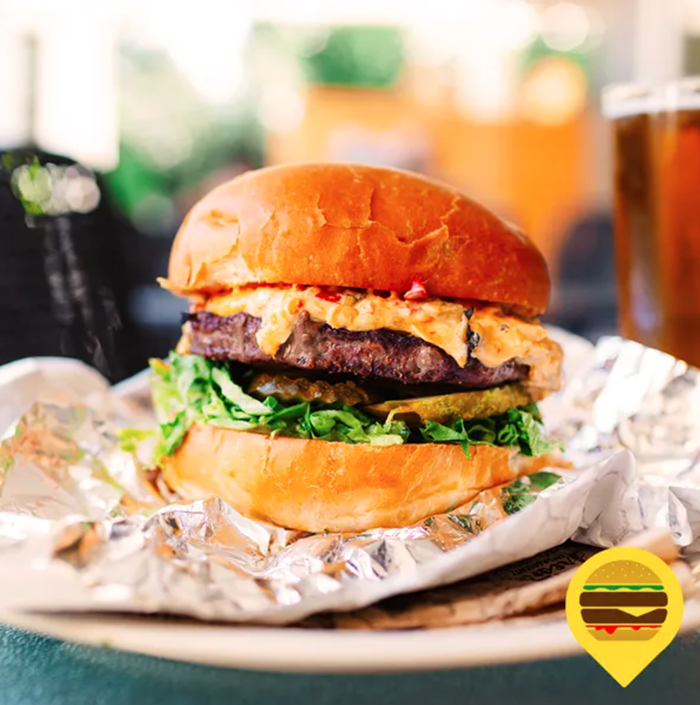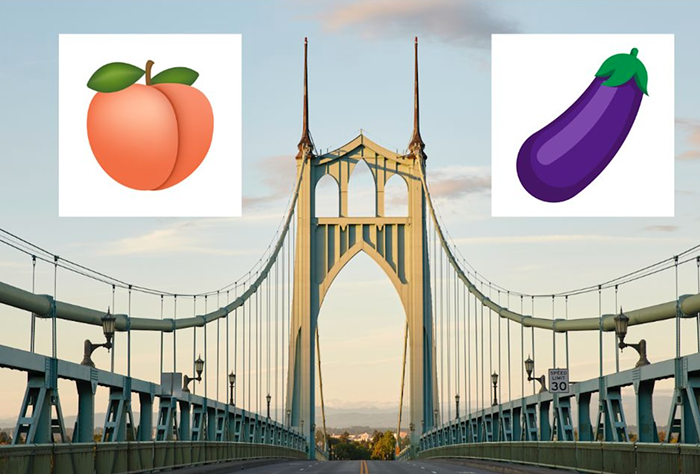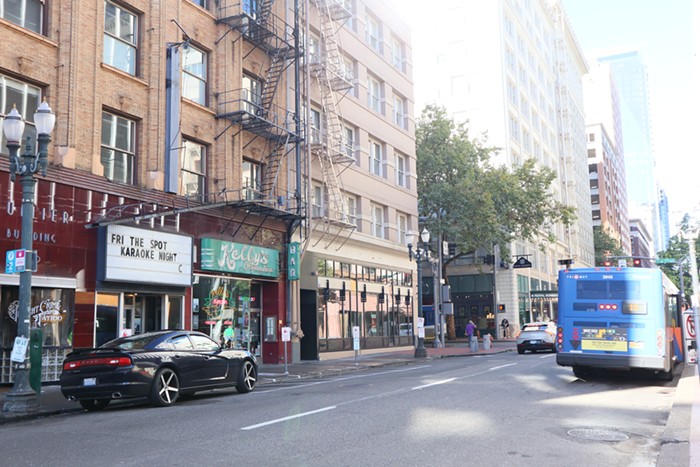"Don't try this at home, kids. This is not Jackass," warned Matt Staab, a chemistry teacher at Cleveland High School, as he put on goggles and started rummaging around in a green plastic box marked "Explosives Kit." His trucker cap said "I [Heart] Chemistry."
Staab visited the Mercury to show us a few ways to blow things up, in honor of America. Many of his experiments can be replicated at home—if, like he says, you're not a kid, and might we add you're not drunk, high, or stupid—but some use top-secret ingredients that only real science teachers (and probably terrorists) can get their hands on.
We tried 'em under Staab's watchful eye, didn't get a visit from the Portland Police Bureau's bomb squad, and lived to tell you all about it. God bless America!
Exploding Acetylene Balloons
Staab pulled out a yellow canister marked "carbide"—the stuff's usually used in miners' lamps—and a bag of balloons, then instructed two volunteers to cram a few rocks of the calcium carbide into the balloons.
"We're going to put a couple in each one," Staab said, and then squirted in some water, and the volunteers quickly tied off the balloons. The exothermic reaction between the calcium carbide and the water produces acetylene gas, which makes the balloons expand.
"Even if it does happen to explode in your hands on accident, it won't hurt you. It just stinks, worse than the worst fart," Staab cautioned. This is true, as
Mercury Editor Wm. Steven Humphrey discovered when his balloon popped and got acetylene (AKA "fart stink") all over his arm.
Volunteer Matt "Always Game" Davis successfully tied his balloon, and Staab taped it to a yardstick so Davis could suspend it over a flame. Staab lit an ethylene burner, set it on a fireproof surface—an overturned old file cabinet in the Mercury's parking lot—and gave Davis the green light.
"When you heat it up, it go boom," he said.
Yes, it did! After a few seconds over the flame, the balloon burst with a gasp-inducing pop and a bright flash of light. And Davis survived.
Noise: Like a balloon popping, obviously
Flash: Quick but bright
DIY-ability: High. You can find calcium carbide at Andy and Bax.
Overall: A winner!
Mentos and Diet Coke
This is a classic DIY "explosion," popular with the YouTube set. It's a physical reaction, Staab explained, as he emptied an entire package of mint Mentos into a paper tube, then instructed volunteer Nick Olmstead to hold the tube over a piece of cardboard, which prevented the Mentos from falling out of the bottom prematurely.
Staab put a bottle of Diet Coke into the middle of the parking lot, and uncapped it. He told Olmstead to line up the tube of Mentos over the bottle, slide the cardboard out from under it so the Mentos would all drop in at once, and then run like hell to avoid being doused with Diet Coke. Olmstead complied.
The reaction—caused by the Mentos screwing with the surface tension of the Diet Coke, and releasing the soda's carbon dioxide—is a geyser of brown sticky liquid erupting 10 feet high. It's over in a second or two. Olmstead, who got a little damp, bravely took a swig of the now-minty Diet Coke. It tasted like "a fizzy-mint sensation, but not really that sweet," he said.
Noise: Stealthily quiet
Flash: No light or flames, just a tall splash of soda.
DIY-ability: High. All materials available at Plaid Pantry.
Overall: Eh. It'll impress small children.
Combustion of Potassium Chlorate
This experiment nearly failed, thanks to the nice summer breeze which interfered with the steady flame needed to liquefy and boil a test tube of potassium chlorate. We fashioned a windscreen MacGruber would be proud of: One of the old file cabinet drawers sheltered the test tube setup.
Eventually, the potassium chlorate—which started as a white powder—melted and started to bubble.
"It produces a lot of oxygen when it liquefies," Staab explained. Once it started to bubble, volunteer Alison Hallett lit a wooden stick and blew out the flame, then put the smoldering side of the stick into the test tube and stood back. "It's going to squirt fire," Staab warned, thanks to the combination of the fuel (the wood) and a high amount of oxygen.
He uses this experiment in class to demonstrate phases, as the solid melts to a liquid phase and then boils to a gas phase. The flames are just an attention getter, he explained.
The flames certainly got our attention! As soon as Hallett dropped the burning stick into the tube, sparks flew. In a few seconds, the little test tube looked like a rocket engine at liftoff.
Noise: A fizzing, gurgling crackle.
Flash: Holy crap! The fire squirting out of this test tube was so white hot, it melted a rubber gasket around the tube and completely blackened the tube.
DIY-ability: Good luck. "If you buy this chemical and you're not a chemistry teacher, then probably George Bush's friends come and get you," Staab says.
Overall: Totally worth finding your nearest chemistry teacher, and asking him or her to demonstrate this one.
Fireworks Colors
While we waited for the potassium chlorate to liquefy, Staab set out six Petri dishes, and busted out six little bottles of inorganic salts. He sprinkled a little of each salt into separate dishes.
This is what fireworks are made out of, he explained, though the combinations are closely guarded secrets.
Then he squirted each dish with ethyl alcohol, and touched a flame to them. Each dish burst into a different color flame—green, red, crimson violet, blue, yellow, and white. He gave us the scientific explanation: "Different cat ions emit different wavelengths of light when you burn them. Electrons hop up and down between their different energy levels, or the shells that they're in, and they emit light," he said.
A bit hard to see in the daylight, Staab stood back and squirted more ethyl alcohol into the dishes, which created a wall of rainbow-hued flames. "Very Harry Potter!" a Mercury staffer yelled like a silly, happy five-year-old.
Noise: Silent
Flash: Ooooh, pretty colors!
DIY-ability: Some of these salts cost more than the fanciest fleur de sel Whole Foods carries. Good luck with that.
Overall: A crowd pleaser that had everyone oooh-ing and ahh-ing.
Instant Fire
"I'm going to mix some sugar and some potassium chlorate," the same stuff we melted in a test tube earlier, Staab explained, setting up a small dish of the white powders. "When I add sulfuric acid to it, so much heat is generated that it catches on fire." No match required! Some folks do this in chemistry class without the potassium chlorate, but the chemical oxidizes so fast, Staab explained, that it accelerates the reaction.
Staab filled a bulb pipette with sulfuric acid and stood back from the dish of sugar and potassium chlorate. "When it does work, it's pretty rapid, so I'm going to do it from a distance," Staab said.
He got a few drops of the acid into the dish, and it exploded into a bowlful of fire! Hooray!
Noise: Ka-boom!
Flash: Like 100 of those lame sparklers burning at once.
DIY-ability: "These are some pretty nasty chemicals," Staab says. Sulfuric acid burns. Don't try this at home.
Overall: Better hit the fireworks stand. You don't want to melt your skin.













